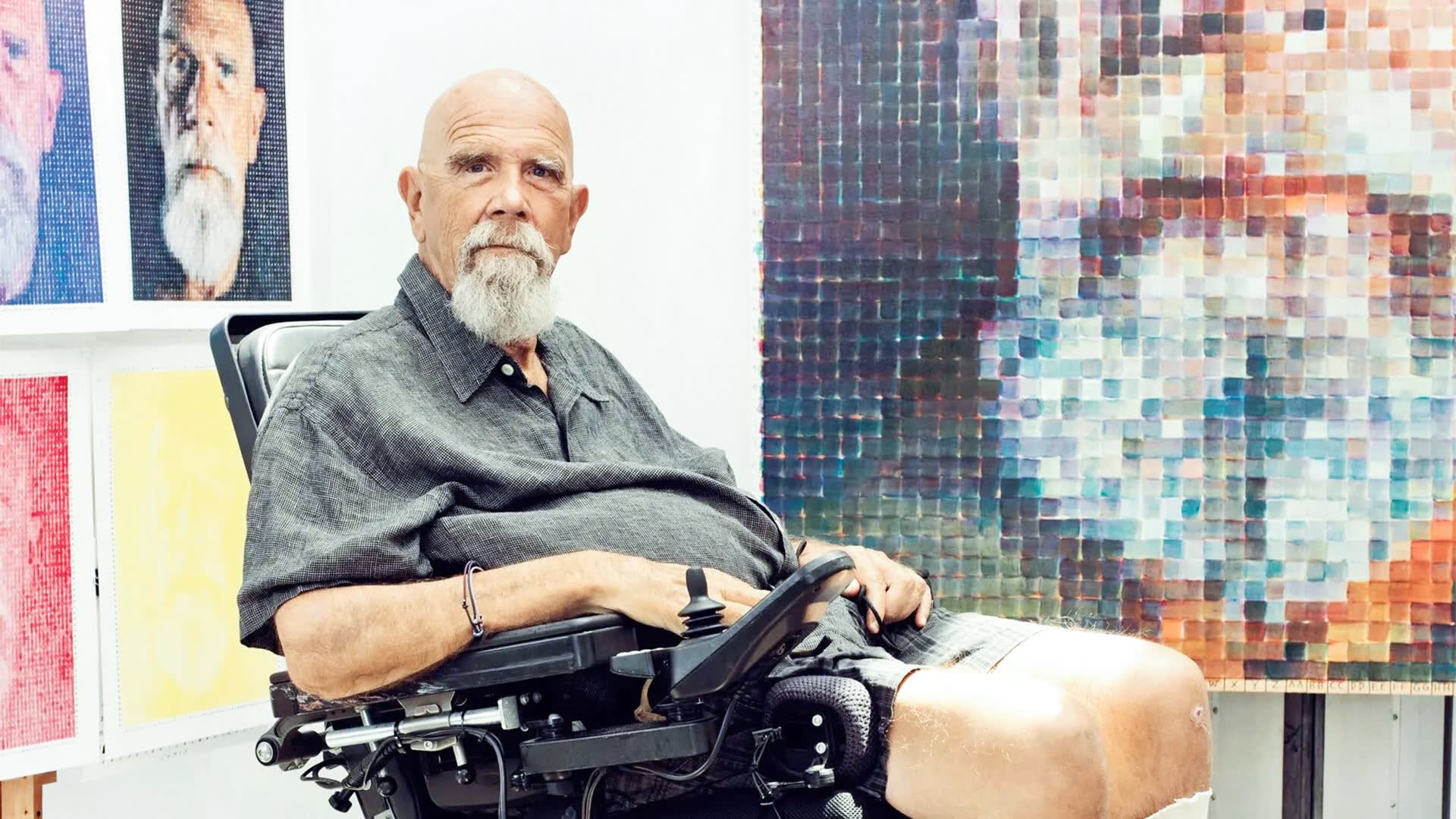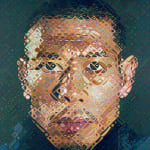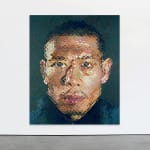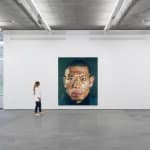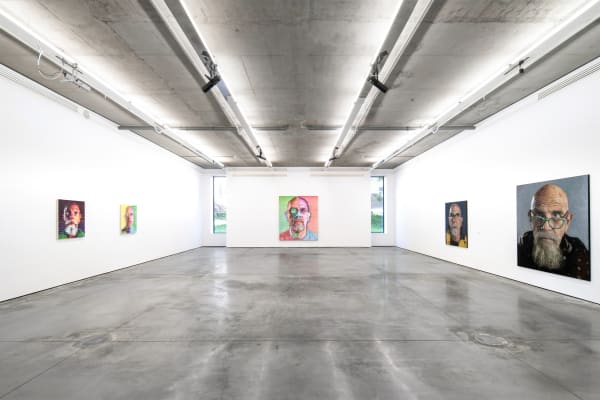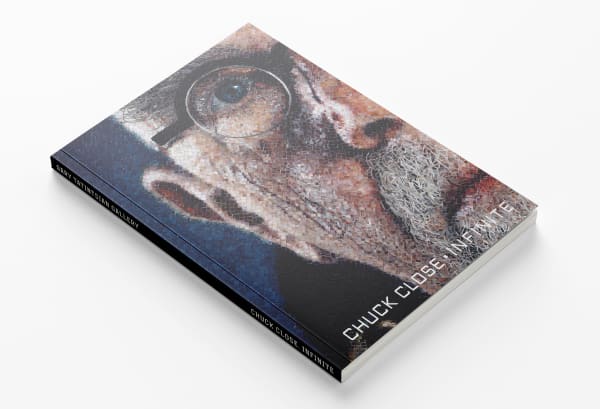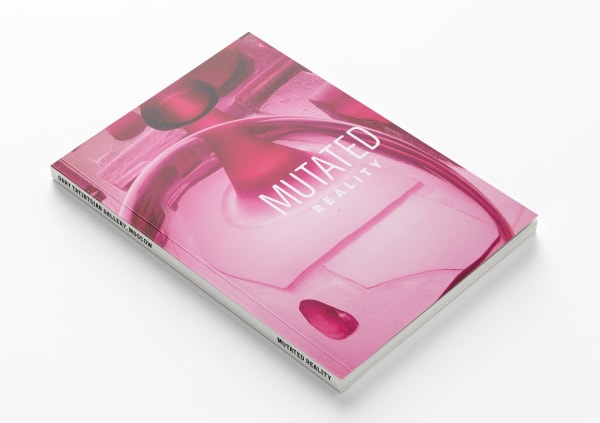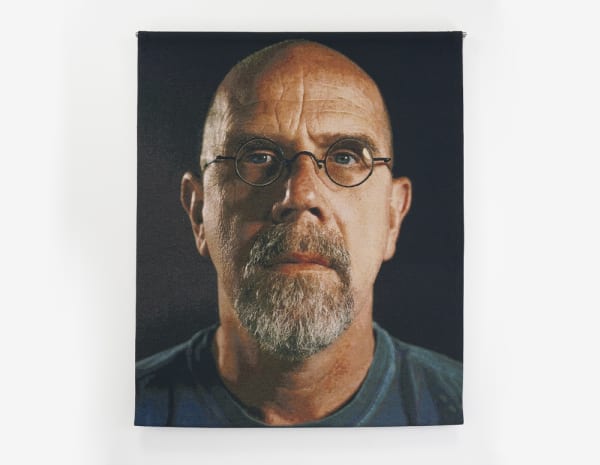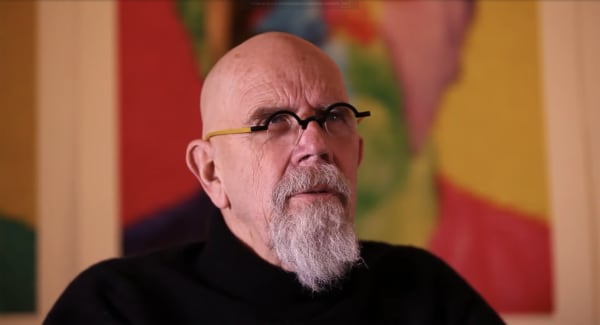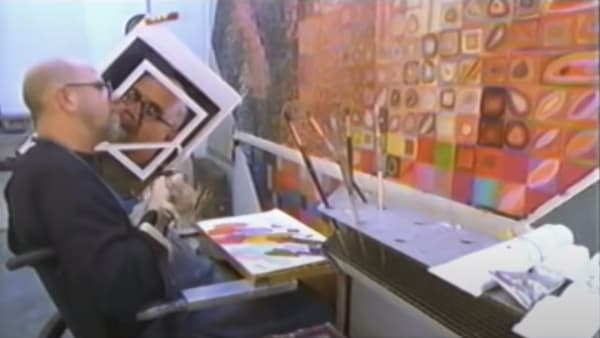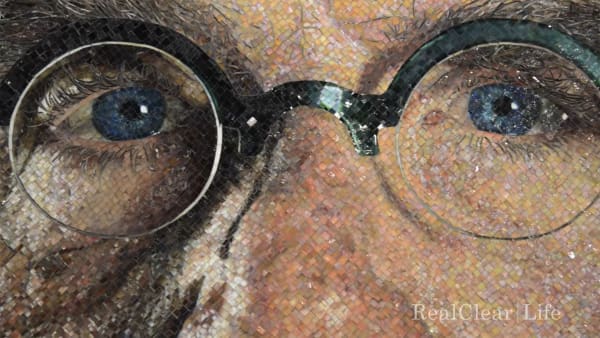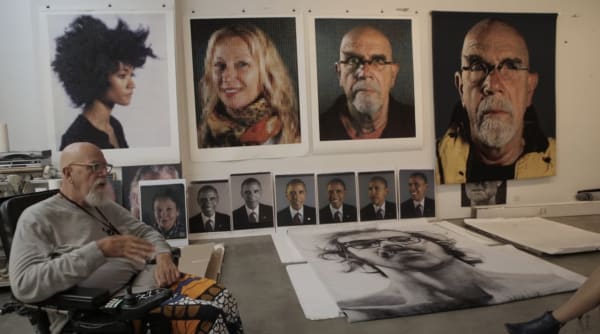Chuck Close 1940, Monroe, WA, USA-2021, Oceanside, NY, USA
-
 Photo by Ryan Pfluger for The New York Times
Photo by Ryan Pfluger for The New York Times -
A legendary portraitist and master of photorealism, Chuck Close was one of the most influential artists of his generation. Renowned for his meticulous detail and innovative techniques, he left a profound mark on both American culture and the international art world.
DOWNLOAD CV >
With an artistic career spanning more than five decades, Close transformed the conventions of portraiture, redefining the academic canon and experimenting across a range of media—from Polaroid photography and oil painting to mosaic tilework and jacquard tapestry. His portraits were constructed through tonal grids built from fingerprints, pointillist dots, brushstrokes, paper pulp, and countless other materials.
Close received his bachelor’s degree from the University of Washington in 1962. Initially immersed in abstraction, he radically shifted his style after graduating from the Yale School of Art in 1964, embracing photorealism. Using large-format Polaroid images, he began transferring them to canvas with unprecedented precision. His first solo show took place in 1967, and in 1971 the Los Angeles County Museum of Art presented a major exhibition of his black-and-white portraits, marking his emergence as a defining figure of contemporary art.
By the late 1970s, Close became one of the first artists to use the camera not only as a preparatory tool but also as an autonomous medium. His signature method involved overlaying a grid on a photograph and systematically transferring it, cell by cell, onto monumental canvases. Within each cell, concentric strokes of color built intricate optical effects that relied on “optical blending”—a phenomenon in which the human eye merges neighboring hues into a unified tone. At the micro level, the eye processes each fragment of color; at the macro level, the grid dissolves into the recognizable image of a human face.
“To observe Close at work on one of the grid portraits is like watching a man patiently working his way through the world’s largest crossword puzzle. As the painting approaches completion, it’s as if the crossword has been miraculously transformed into biography, the components finding syntax that gives them cumulative meaning.”
— Christopher Finch
Despite significant physical challenges, Close never abandoned his pursuit of portraiture. After a spinal artery collapse in 1988 left him partially paralyzed, he adapted his working methods and continued to paint with remarkable determination. He also lived with prosopagnosia (face blindness), a condition that made it difficult to recognize faces but that ultimately strengthened his commitment to portraiture. Painting became a way to preserve the visages of friends, family, and cultural figures, transforming a personal necessity into an art form of profound and universal resonance.
Close’s portraits—whether of celebrities such as Kate Moss, Brad Pitt, and Lou Reed, Presidents Bill Clinton and Barack Obama, or of fellow artists and family members—were never mere likenesses but profound psychological studies. Each work unfolds as a biography in color and form, where every imperfection becomes inseparable from identity.
“A face is a road map of someone’s life. Without any need to amplify that or draw attention to it, there’s a great deal that’s communicated about who this person is and what their life experiences have been.”
— Chuck Close
Chuck Close received the National Medal of Arts and was appointed by President Barack Obama to the President’s Committee on the Arts and Humanities. He was a member of the American Academy of Arts and Letters and served on the boards of leading arts institutions.
His work has been exhibited in hundreds of shows worldwide and is represented in major collections, including the Museum of Modern Art (New York), Tate Britain (London), the Metropolitan Museum of Art (New York), Centre Pompidou (Paris), the National Portrait Gallery (London), the Hiroshima City Museum of Contemporary Art, and the Suermondt-Ludwig-Museum (Aachen), among many others.
-
Works
Chuck Close 1940, Monroe, WA, USA-2021, Oceanside, NY, USA
Zhang Huan I, 2008Oil on canvas
257,8 × 213,4 cmFurther images
'The face is a picture of human struggle and human joy. It’s all of life right there.' — Chuck Close Chuck Close often described the feeling of 'getting lost' in..."The face is a picture of human struggle and human joy. It’s all of life right there." — Chuck Close
Chuck Close often described the feeling of "getting lost" in his creative process, comparing the canvas surface to a geographical map—both a guide and a riddle for the viewer. His signature grid system allowed each fragment to stand as an independent image, with every vibrant square functioning as a fully realized painting in itself.In ZHANG HUAN I, a portrait of the contemporary artist Zhang Huan, this interplay between abstraction and realism creates a striking tension. The image hovers between sharp photographic clarity and the brink of dissolving into pure abstraction, constantly shifting in perception.
Exhibitions
Chuck Close. Blum and Poe, Los Angeles, Oct 29–Dec 22, 2011
50 Years at Pace. The Pace Gallery, New York, Sep 17–Oct 16, 2010
Chuck Close: Selected Paintings and Tapestries 2005–2009. Pace, New York, May 1–Jun 20, 2009
Publications
Bui, Phong. “In Conversation: Chuck Close with Phong Bui.” Brooklyn Rail, June 2008 p. 32.
Mason, Brook S. “How Grandma’s Crochet Inspired My Artistic Vision.” Art Newspaper no. 201 (April 2009) p. 44.
Wei, Lilly. “Face Time.” In Chuck Close: Selected Paintings and Tapestries 2005-2009. Exhibition catalogue. New York: Pace Wildenstein, 2009. pp. 1, 9, 26, 27.
Falconer, Morgan. “An American Trilogy, Part III: Realism, Chuck Close.” With sidebar text by Madeleine Grynsztejn. Art World, no. 11 (June/July 2009) pp. 44.
Glimcher, Arne. 50 Years at Pace. Exhibition catalogue. New York: The Pace Gallery, 2010. pp. 275, no. 157.
Finch, Christopher. Chuck Close: Work. Munich; Berlin; London; New York: Prestel Verlag, 2007; 2010; 2014. pp. 318, 322.
“Memorias Cuadriculadas (Squared Memories).” In 100 Miradas al Arte Contemporáneo (100 Views on Contemporary Art). Santiago: Arte al Límite, 2014. p. 16.
Tony, Godfrey. “Chuck Close.” RES: Art World/World Art, no. 11 (2014) p.17.Chuck Close: Paintings, 1967 to the Present. Digital Catalogue Raisonné. Artifex Press, 2016.
7/ 7Exhibitions-

Chuck Close. Infinite
Personal Exhibition 18 Jun - 27 Nov 2021A legendary portrait painter and master of photorealism, Chuck Close is one of the most influential artists of his generation, renowned for his meticulous detail and innovative technique, which deeply...Read more > -

Mutated Reality
Group Exhibition 27 Nov 2015 - 2 Mar 2016Read more >
PublicationsViewing RoomsNewsVideo-

Up Close And Personal
© Vanity Fair -

Chuck Close: A Portrait in Progress
© The Art Kaleidoscope Foundation, MUSE Film & Television -

RealClearLife Exclusive: Artist Chuck Close Gives Tour of His Work in NYC Subway
© RealClearLifeFor the first time ever, Chuck Close gave a personal, guided tour of his 12 portraits in the new 86th Street Q train station. In conjunction with DeCubellis Films, RealClearLife... -

Meet Chuck Close
© MCA Australia
